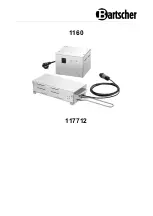
6. Loop the end of the aircraft cable around the eyebolt and back to the
aircraft cable. Secure this end of the cable to the main aircraft cable with the wire
rope clamp.
7. Turn the loudspeaker over and feed the other end of the aircraft cable through
the eyelet in the bottom of the loudspeaker.
8. Loop this end of the aircraft cable around the eyelet and back to the aircraft
cable. Secure this end of the cable to the main aircraft cable with the wire rope
clamp. The upgraded attachment should now look like Figure 14.
Final Adjustments
Now that the loudspeaker’s phase, operation and security is assured, there are some
final steps to ensure that the loudspeakers installation is complete and that they are
used at there full potential.
1. Cover any trenches or wires that are still open or exposed.
2. Point the loudspeakers per the layout and verify that the sound is even and
consistent throughout the area that sound is desired, as you did in step 5 of
verifying system operation.
3. Verify that the front of the loudspeaker is as close to perpendicular to the ground
as possible. This will aid the drainage of water away from the woofer and
improve sound quality.
4. Check that the entire installation is safe and secure.
INST
ALLA
TION
OPERA
TION
18
17
OPERATION
Listening at Higher Volumes
Outdoors there are no walls to reflect and contain the sound and typically
the ambient noise level is louder. This causes the system to require more power
to achieve a reasonable listening level than it does when you are listening indoors.
In addition, you are frequently further away from the loudspeaker. It is possible
to turn the volume so high that the amplifier runs out of power. This creates
”clipping” distortion.
Clipping distortion makes treble sound very harsh and unmusical. When you hear
harsh sounding treble from any good speaker indoors or outdoors, turn the volume
down immediately! Those harsh sounds are masking some much more powerful
ultra-high-frequency sound spikes that will quickly damage any fine loudspeaker.
Cleaning
The rock loudspeaker should not require cleaning. The formation of dirt and molds
on the cabinet will add to the natural look of the loudspeaker. However, if
you desire to clean the loudspeaker you can clean the RS8Si with a dampened soft
cloth or a paper towel. Hosing the loudspeaker off with a garden hose or high
pressure cleaner is not recommended, the drivers, especially the tweeter, can be
damaged by a high-pressure stream of water. The use of chemical cleaners should
also be avoided.
Concrete
Anchor
Wire Rope Clamps
Eyelet
Rock Speaker
Aircraft Cable
Figure 14 Upgraded Security Attachment






























